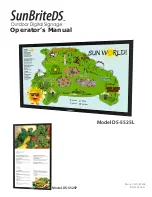
6
LISST-Holo2
User’s Guide
1
Introduction to the LISST-Holo2 and In-Line Holography
Thank you for purchasing the LISST-Holo2 Submersible Digital Holographic Camera!
The LISST-Holo2 uses the technique called digital in-line holography to obtain in focus images of particles suspended in water.
The holographic method allows all particles within the 50mm long sample volume to be in focus and see details down to 4 microns
in size. In line-holography permits only the view of silhouettes (profiles) of individual particles. It permits undisturbed views of the
most fragile flocculated particles (flocs), or plankton and other material. The name ‘in-line’ derives from the fact that a laser beam
passing through water is directly imaged on an imaging sensor (e.g. CCD). Thus, the image is made of the overlap of the
unscattered laser light and light scattered by particles in the beam. Because this overlap produces interference fringes, the images
(‘holograms’) look like a set of concentric rings or other blurred shapes. The holograms are stored as uncompressed image files.
To see actual particles in the beam, a hologram must be processed
– a Reconstruction is required. This is done via digital
processing. The reconstruction essentially focuses particles at different distances from the imaging sensor. In the case of our
LISST-Holo2, the laser beam between glass windows is 5 cm long, and particles are reconstructed at 100 planes (normal to the
laser beam), each 0.5 mm apart. Thus, from one hologram, 100 in-
focus ‘photographic’ frames are produced, and particles appear
in sharp focus at the plane where they existed. The reconstruction software is provided.
Holography is data intensive. Each hologram of the LISST-Holo2 is about 2MB. At 20Hz, that would mean a data rate of
40MB/sec. A user may slow down the frame rate, and also schedule the frame capture using provided software. A 10-minute full-
speed capture would produce 12,000 holograms, i.e. 24GB of data!
The large number of holograms that might be collected in some experiment requires a method to sort them by importance.
Beginning with LISST-Holo2, Sequoia is introducing a new algorithm that quickly ranks holograms by the richness of images in
them, so that you may see the most interesting ones first, and so on.
The intent with this User Manual is to get you started using the LISST-Holo2
as quickly as possible. Sequoia’s goal with the
LISST-Holo2 is to make the user interface so friendly that no manual would be required for normal operation, except as a first-
time introduction to the instrument. The following pages contain a Quick Start section and a Getting Started Section. The Quick
Start section is a very brief introduction to the operation of the LISST-Holo2. It is intended for experienced user as a refresher or
for people who do not want to read a manual. The Quick Start section walks the user through the steps necessary to obtain and
process images.
Sequoia Scientific, Inc. is pleased that you have chosen one of our products. Thank you! If you should have any difficulties or
questions regarding this product, please feel free to contact us at
Summary of Contents for LISST-Holo2
Page 2: ......







































